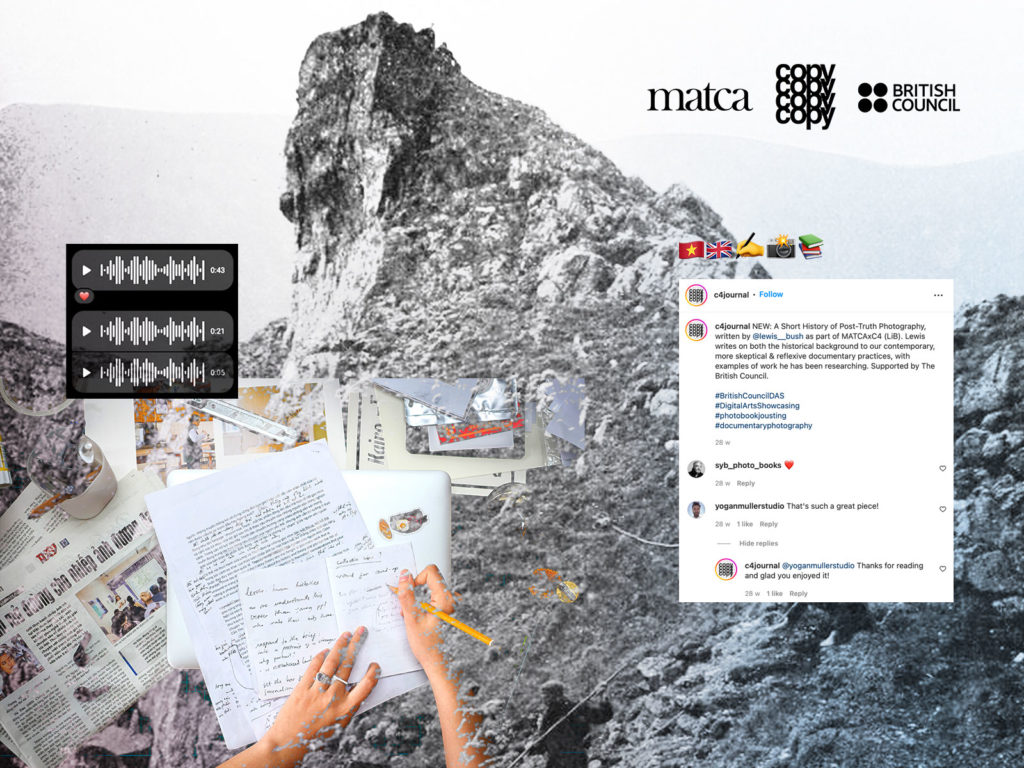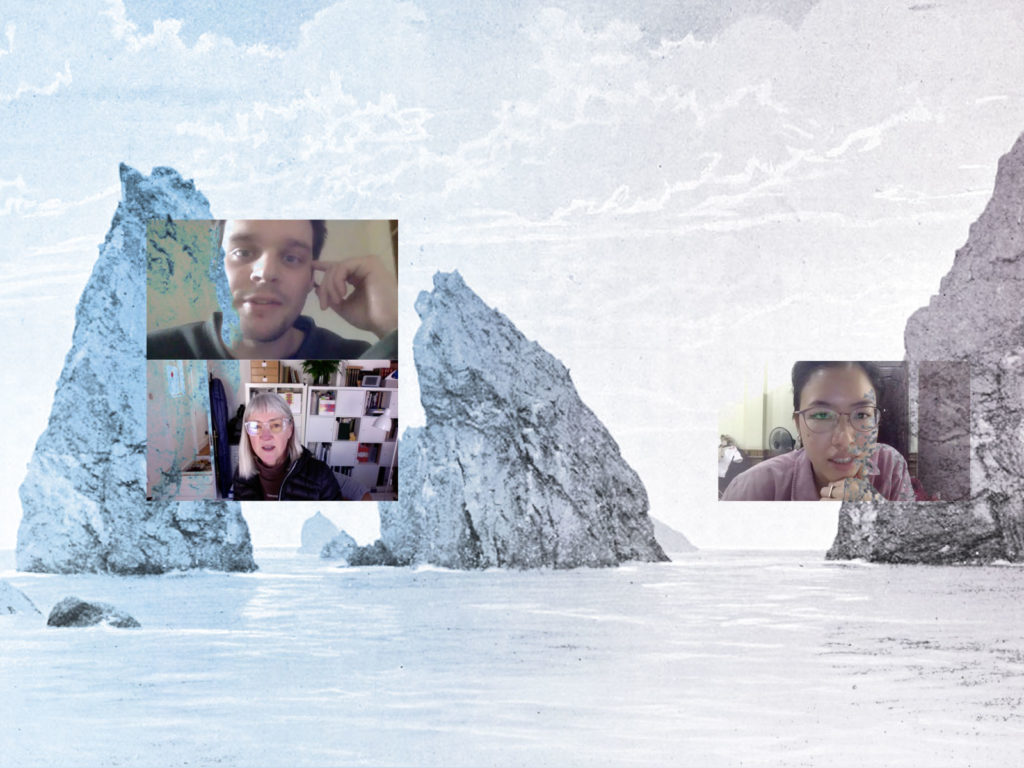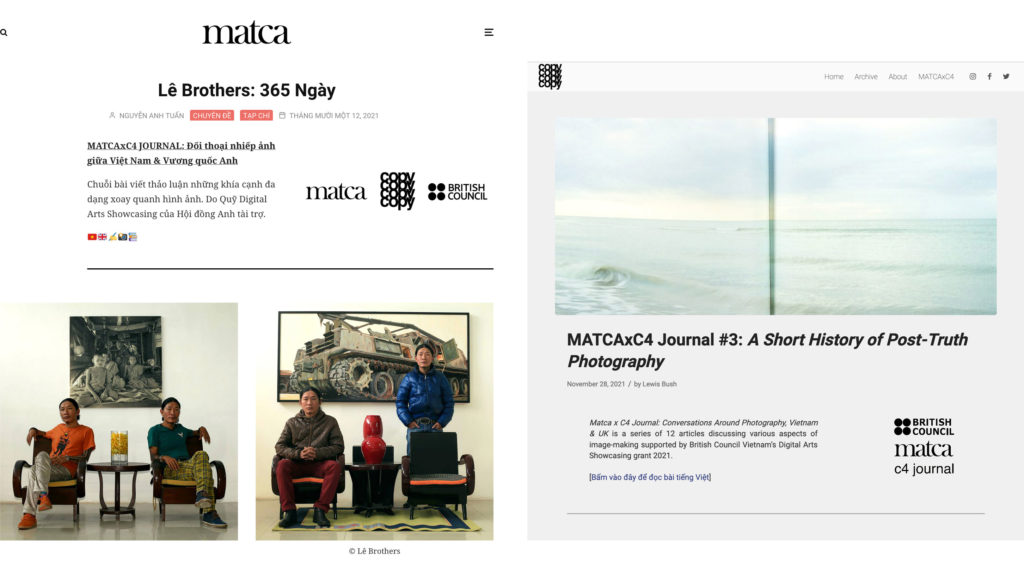MATCAxC4 JOURNAL: Conversations Around Photography, Vietnam & UK
A series of articles discussing various aspects of image-making. Supported by British Council Vietnam’s Digital Arts Showcasing grant 2021.
????✍️??

Following British Council Vietnam’s Digital Arts Showcasing grant in November 2021, two independent platforms Matca (Vietnam) and C4 Journal (the UK) kickstarted a series of 12 articles on photography, available on both websites in English and Vietnamese. The premise was simple: to catch up with movements in respective countries through work features, interviews with practitioners, and op-eds exploring current issues in image-making.
The journey over the past months was as illuminating as it was nerve-wracking. While we took this rare opportunity to unravel important stories, there were several hiccups, including navigating disparate contexts and juggling editorial duties in less than ideal circumstances. As our collaboration nears its end, editors from both sides sit down to discuss difficulties encountered and lessons learned along the way.

What have we learned from each other over the past few months?
Hà Đào (H): I am inspired by your consistent focus on community and dedication to uplifting emerging voices. It has encouraged me to make a deliberate effort to highlight new works in the making instead of waiting around for a masterpiece, as well as champion image-makers from groups that have been systematically marginalised: women and queer people, those from disadvantaged backgrounds, and those engaging with topics considered “sensitive” at significant personal risk. Not just to pay lip service but to hopefully spark nuanced discussions about their practices starting with addressing their very necessity.
Writings on photography do not only analyze formal qualities but touch on various contexts. Due to the current world order that places Vietnam at the peripheral and the UK at the center of photography (or of anything considered culturally significant), certain exchange programs implied that we should learn the best practice from the UK as a more developed industry, and not vice versa. While in reality, what works in the UK won’t automatically work in Vietnam because our infrastructure is entirely different. Let’s take independent spaces for example. An abundance of artist-led initiatives could stand for decades in the UK, yet even when replicating a successful model, ones in Vietnam still face persistent issues of funding, human resources, and censorship, and thus tend to be much more short-lived. Yet at the same time, it is eye-opening to read about your vibrant history of independent spaces as a reminder that art could thrive given the right people and circumstances. Sometimes I wonder what could be achieved if there were no practical constraints, since we’ve been so so used to them.
Callum Beaney (C): I really appreciate anyone trying to get the word out about what’s going on in their corner of the world. Ever since I found out about Makét, I think I knew I wanted to work with Matca in one way or another – that kind of thorough interest in history and visual culture is pretty rare.
I do believe that, culturally speaking, the UK’s circumstances are not as stable as we might expect. Our “canon” so to speak may face something of a historical crash in the near future. Our main means of disseminating work is so ephemeral – web pages and whole sites die like flies. Books, which shaped the more recent North-American and Japanese photographic canons, are now so expensive and so quickly sold into the forever-inaccessible libraries of collectors, that those which are even remotely historically significant will be absorbed into archives, and maybe digitised for public view when they’re worth so much that only academics and aristocrats can view them in person (you can even see this with recent history books about photobooks!). Many of our more long-standing institutions like the British Journal of Photography, and many independent collectives and non-profit organisations are rapidly changing hands and grasping for new sources of funding. It’s pessimistic, but I don’t think we will maintain the same influence or historical cohesion for long. I believe that a more ephemeral, fragmented and mostly locally-contextualised UK scene will likely emerge over the next 30 years unless things change.
Due to the current world order that places Vietnam at the peripheral and the UK at the center of photography (or of anything considered culturally significant), certain exchange programs implied that we should learn the best practice from the UK as a more developed industry, and not vice versa.
– Hà Đào

Eugenie Shinkle (E): I agree with Cal’s assessment of the Western photographic canon and its future, but I’ve got a bit more optimistic outlook on what this might mean for photography’s ‘periphery’. It’s true that the infrastructure here (and in Europe and North America) has deeper roots and offers more options (financial, logistical, etc.) for smaller organisations. But there’s also a strong commitment to more inclusive and globally representative programming and publishing, and, I think, a commitment to learning from the groups that they work with, rather than the traditional ‘white saviour’ approach of discovering unknown work and inserting it into Western photographic history. This is evident in larger organisations, publishers and awards all the way down to local groups – the diversity of publics they’re engaging with, the kind of work they’re showing, and the way they are approaching it. There are few, if any, institutions in the UK that I can think of who are still devoted exclusively to maintaining the white Western male canon. There’s still a long way to go, but my feeling is that there’s a shift in the sense of proprietorship that Western institutions have maintained in the past, and more of a willingness to work in a more egalitarian way with the photographic communities that they engage.
We do have a very specific kind of work about Vietnam burned into our retinas – images that define the country for the Western imagination, and that are very difficult to dislodge from the collective consciousness. Since the Vietnam War, photographic interest in East Asia has gravitated towards China and Japan. As far as Cambodia, Philippines, Myanmar, Thailand, Singapore, and the other Southeast Asian countries – apart from certain specialists, I’d say that our knowledge of photographic history and culture in these countries is very limited.
H: That’s exactly why I wanted to include an interview with Indonesian photographer Muhammad Fadli in this series. Just because we are geographically closer doesn’t mean we are familiar with the goings-on in the region nor look there for inspiration, quite the opposite is true. But that is a topic for another day.
While the war-related representation of Vietnam persists, I wouldn’t see resisting it as the hill to die on. Throughout this project, we continue to seek and publish contemporary works that we think deserve attention, as there are always undercurrents beneath the quiet surface. We stick to this original purpose and thus free ourselves from the silly pressure of “representing” the country, a common sentiment in exchange programs. Enriching international audiences’ perception of photography from Vietnam and of the country itself is an added benefit, not an overriding ambition.
Early on, we have talked about “decolonising” writing around photography – the push back from applying Western critical frameworks to works produced in other contexts. The reflex to quote an established scholar or compare a young local artist to a household name is still ubiquitous, not just in this project but in art writing in Vietnam at large, perhaps for a sense of legitimacy or to appeal to certain audiences. It is not necessarily bad but we should acknowledge the phenomenon – all while accepting that there is no getting away from the Western canon, as local cafe shops don English philosophical quotes on their storefront and neoclassical architecture gains popularity in urban and rural Vietnam.
I do believe that, culturally speaking, the UK’s circumstances are not as stable as we might expect. Our “canon” so to speak may face something of a historical crash in the near future.
– Callum Beaney

What difficulties have we encountered?
H: Let me start by stating that writing is definitely a labor of love. Many hours have been spent on finding the suitable angle, going back and forth with writers to clarify a point, or pulling my hair out over an awkward expression. Writing in English as a second language is difficult, but it’s not at all easier in my mother tongue since there isn’t an abundance of examples in Vietnamese to learn from. Critical discussions initiated by practitioners are scattered, while the accredited photography curriculum draws heavily from that of former Soviet countries like Russia or East Germany – also a Western canon, albeit a very different and not so up-to-date one.
Issues like ethical concerns, the relationship between images and truth, and publications in the form of books or zines might have been largely covered in English-language literature, but remain very novel in the local context. Such novelty leads to multiple issues of translations as the exact term in Vietnamese might not exist, or phrases end up sounding foreign on the tongue. Common words like “narrative” or “institution” are strangely hard to translate. Even the word “curator” was in fact introduced to Vietnam (but not without controversy) as recently as about 20 years ago. It was when the rising number of independent art exhibitions prompted the need for such a position, which did not exist in previous state-organized exhibitions. Debates over the definition, followed by ones over the role of a curator, are taking place up until this day. In short, the main challenge entails bridging the gaps in both knowledge and in the vernacular.
C: Yes, translation is exhausting. Technology is nowhere near ready to take over. I’ve had similar experiences handling English → Japanese interviews.
… Really fundamentally, finding the time for both writing and editorial duties can be extremely challenging when life and work start becoming unbalanced. Photography as a whole is something I do out of love – I write on what I find exciting and want to share with fellow nerds, and I make my own little dummies with a rubbish xerox copier. But you know, I’m retraining in software… it is not viable as a career.
E: I work full time in an academic institution and run C4 with Cal in my spare time. It’s exhausting (I also try to maintain a photographic practice, and to sleep now and then…), but it’s also a lifeline for me. I’ve grown increasingly dissatisfied, over the past several years, with the landscape of academic publishing – it’s very insular, very time-consuming, and the outcomes are often inaccessible (logistically and semantically) to wider audiences. One of our mandates is to bring our combined knowledge and passion (and by this I mean everyone who writes for C4) to any interested reader with an internet connection, free of charge. That’s so much more meaningful to me at this point in my career than yet another paper in an academic journal.
There’s still a long way to go, but my feeling is that there’s a shift in the sense of proprietorship that Western institutions have maintained in the past, and more of a willingness to work in a more egalitarian way with the photographic communities that they engage.
– Eugenie Shinkle

Where do we go from here now that the project has finished?
C: Lots of interviews and translation with folks making work Japan & China-side… I’m also working on a few “analytic explanations of continental ideas” type articles, trying to make some of those old theoretical works a little more approachable. Outside of C4, I will be working on a project looking at some of what is going on in Southeast Asia soon, and making some visual work in collaboration with friends including Eugenie.
E: We started C4 with no financial model in mind, and for the last 18 months we’ve been pretty much operating as a gift economy, but we’ve grown more quickly than we anticipated, and it’s time for us to start thinking about how we can fund the site and pay our writers. At the moment they get free books (and mentoring, when appropriate) but it would be great to be able to offer a small honorarium too. I’m also looking for ways to link C4 to my institutional work in a more meaningful way – graduate internships, for instance – opportunities for students to get a taste of how these sorts of initiatives work in the real world. Collaborations like this one are incredibly valuable, and I’d like to find ways to make more of them happen.
H: I will take a short break from online publishing to focus on Matca’s upcoming book, build a more frequent community program in our physical space now that social distancing measures have eased, and focus on my personal photographic work. The core goal remains to build a community at home where photographers could sustain their practice and support one another. At the end of the day, what’s the point of art writing if the art scene remains stagnant?
That does not mean quitting writing altogether. I will of course keep an eye on new works and dialogues from C4 and other virtual spaces, including Writing Foto, a blog collating writings on photography from South/east Asia.
Our biggest thanks go to C4 Journal’s editors and contributors, Matca’s tiny editorial team who treated complex subjects with incredible care, and the British Council Vietnam for their support and respect for creative freedom.
